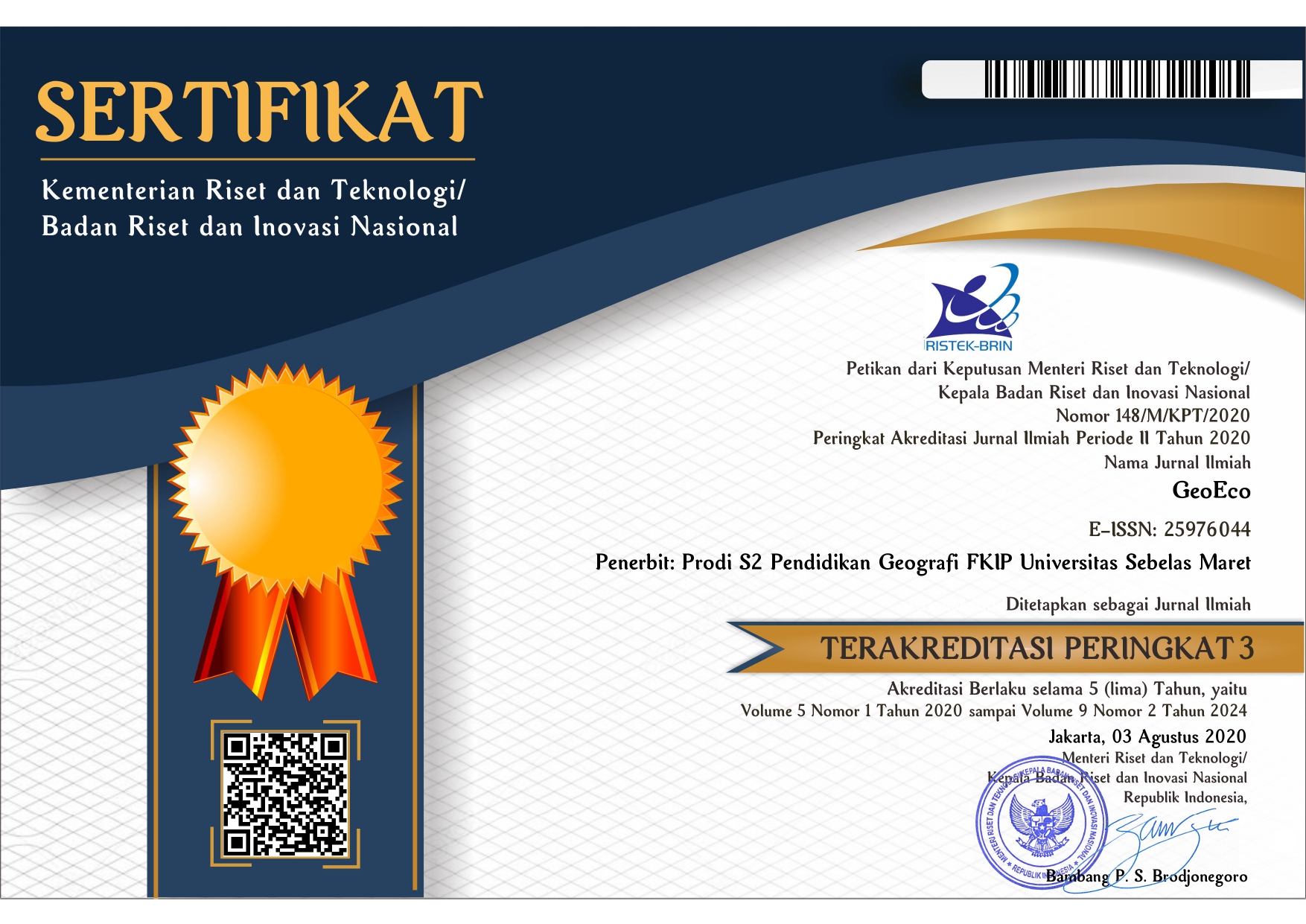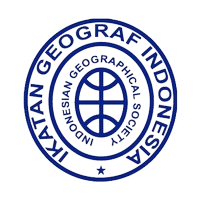APPLICATION OF THE E-LEARNING MODEL IN EARTHQUAKE LEARNING TO IMPROVE STUDENTS' UNDERSTANDING OF EARTHQUAKE DISASTER PREPAREDNESS
Abstract
This study aims to describe the application of e-learning in improving students' understanding of earthquake disaster preparedness. This study used a quasi-experimental design with an equivalent time series type. The research sample was taken of grade 10 Senior High School 5 Banda Aceh with a non-probability sampling method. The stage of this research is that students are given a pre-test to see their initial level of understanding before being given a treatment, then students are given a treatment in the form of earthquake preparedness learning through the e learning model. the understanding of students after participating in learning with the e learning model has increased by 14.44 %. As for the n-gain value is 0.54 (moderate criteria), the N-gain value indicates that learning with the e-learning model is effective in improving students' understanding of earthquake disaster preparedness. based on research data analysis it was seen that students' understanding of earthquake disaster preparedness had increased compared to before. Meanwhile, related to the effectiveness of learning, based on data analysis, it was found that learning earthquake disaster preparedness using the e-learning model was effective in increasing students' understanding of earthquake disaster preparedness.
Keywords
Full Text:
PDFReferences
Alem, D., Bonilla-Londono, H. F., Barbosa-Povoa, A. P., Relvas, S., Ferreira, D., & Moreno, A. (2021). Building disaster preparedness and response capacity in humanitarian supply chains using the Social Vulnerability Index. European Journal of Operational Research, 292(1), 250–275. https://doi.org/10.1016/j.ejor.2020.10.016 Asvial, M., Mayangsari, J., & Yudistriansyah, A. (2021). Behavioral Intention of e-Learning: A Case Study of Distance Learning at a Junior High School in Indonesia due to the COVID-19 Pandemic. International Journal of Technology, 12(1), 54–64. https://doi.org/10.14716/ijtech.v12i1.4281 Bock, A., Kniha, K., Goloborodko, E., Lemos, M., Rittich, A. B., Möhlhenrich, S. C., Rafai, N., Hölzle, F., & Modabber, A. (2021). Effectiveness of face-to-face, blended and e-learning in teaching the application of local anaesthesia: a randomised study. BMC Medical Education, 21(1), 1–8. https://doi.org/10.1186/s12909-021-02569-z Caeiro, S., & Azeiteiro, U. M. (2020). Sustainability assessment in higher education institutions. Sustainability (Switzerland), 12(8), 10–13. https://doi.org/10.3390/SU12083433 Foo, C. chung, Cheung, B., & Chu, K. man. (2021). A comparative study regarding distance learning and the conventional face-to-face approach conducted problem-based learning tutorial during the COVID-19 pandemic. BMC Medical Education, 21(1), 1–6. https://doi.org/10.1186/s12909-021-02575-1 Herdiansyah, H., Husein, S. I., Asrofani, F. W., Simamora, P. A. R., & Kholila, B. N. (2020). Disaster Awareness through Disaster Preparedness Education for Primary Schools. IOP Conference Series: Earth and Environmental Science, 519(1). https://doi.org/10.1088/1755-1315/519/1/012016 Katsumata, A., Tanaka, M., & Nishimiya, T. (2021). Rapid estimation of tsunami earthquake magnitudes at local distance. Earth, Planets and Space, 73(1). https://doi.org/10.1186/s40623-021-01391-7 Lestari, F., Jibiki, Y., Sasaki, D., Pelupessy, D., Zulys, A., & Imamura, F. (2021). People ’ s Response to Potential Natural Hazard-Triggered Technological Threats after a Sudden-Onset Earthquake in Indonesia. Majdi, M. K., & Subali, B. (2018). Peningkatan Komunikasi Ilmiah Siswa SMA melalui Model Quantum learning One Day One Question Berbasis Daily Life Science Question. UPEJ Unnes Physics Education Journal, 7(1), 81–90. https://doi.org/10.15294/upej.v7i1.22479 MILIĆEVIĆ, V., DENIĆ, N., MILIĆEVIĆ, Z., ARSIĆ, L., SPASIĆ-STOJKOVIĆ, M., PETKOVIĆ, D., STOJANOVIĆ, J., Krkic, M., Milovančević, N. S., & Jovanović, A. (2021). E-learning perspectives in higher education institutions. Technological Forecasting and Social Change, 166(October 2020). https://doi.org/10.1016/j.techfore.2021.120618 Munif, M., Umiarso, Mardia, Laili, N., Sa’dia, H., & Muhid. (2021). Integration of Distance Learning Design and e-Learning in Madrasah. Journal of Physics: Conference Series, 1779(1). https://doi.org/10.1088/1742-6596/1779/1/012070 Munzil, Sutrisno, S., Dasna, I. W., & Laksmana, S. D. (2021). Development of main group element digital encyclopedias as learning resources to support learning activities at home in COVID-19 pandemic condition. AIP Conference Proceedings, 2330. https://doi.org/10.1063/5.0043251 Nismalasari, Santiani, & Rohmadi, M. (2016). Penerapan Model Pembelajaran Learning Cycle Terhadap Keterampilan Proses Sains dan Hasil Belajar Siswa Pada Pokok Bahasan Getaran Harmonis. Edusains, 4(2), 83. Rababa, N. (2021). The effect of e-learning in developing high thinking skills. International Journal of Data and Network Science, 5(1), 43–46. https://doi.org/10.5267/j.ijdns.2020.11.004 Vasodavan, V., DeWitt, D., Alias, N., & Noh, M. M. (2020). E-moderation skills in discussion forums: Patterns of online interactions for knowledge construction. Pertanika Journal of Social Sciences and Humanities, 28(4), 3025–3045. https://doi.org/10.47836/PJSSH.28.4.29 Wisanti, Ambawati, R., Putri, E. K., Rahayu, D. A., & Khaleyla, F. (2021). Science online learning during the covid-19 pandemic: Difficulties and challenges. Journal of Physics: Conference Series, 1747(1). https://doi.org/10.1088/1742-6596/1747/1/012007 Yari, A., Zarezadeh, Y., Fatemi, F., Ardalan, A., Vahedi, S., Yousefi-Khoshsabeghe, H., Boubakran, M. S., Bidarpoor, F., & Motlagh, M. E. (2021). Disaster safety assessment of primary healthcare facilities: a cross-sectional study in Kurdistan province of Iran. BMC Emergency Medicine, 21(1), 1–9. https://doi.org/10.1186/s12873-021-00417-3
Refbacks
- There are currently no refbacks.












.png)

